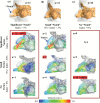Nasal Structural and Aerodynamic Features That May Benefit Normal Olfactory Sensitivity
- PMID: 29474516
- PMCID: PMC5913651
- DOI: 10.1093/chemse/bjy013
Nasal Structural and Aerodynamic Features That May Benefit Normal Olfactory Sensitivity
Abstract
Nasal airflow that effectively transports ambient odors to the olfactory receptors is important for human olfaction. Yet, the impact of nasal anatomical variations on airflow pattern and olfactory function is not fully understood. In this study, 22 healthy volunteers were recruited and underwent computed tomographic scans for computational simulations of nasal airflow patterns. Unilateral odor detection thresholds (ODT) to l-carvone, phenylethyl alcohol (PEA) and d-limonene were also obtained for all participants. Significant normative variations in both nasal anatomy and aerodynamics were found. The most prominent was the formation of an anterior dorsal airflow vortex in some but not all subjects, with the vortex size being significantly correlated with ODT of l-carvone (r = 0.31, P < 0.05). The formation of the vortex is likely the result of anterior nasal morphology, with the vortex size varying significantly with the nasal index (ratio of the width and height of external nose, r = -0.59, P < 0.001) and nasal vestibule "notch" index (r = 0.76, P < 0.001). The "notch" is a narrowing of the upper nasal vestibule cartilage region. The degree of the notch also significantly correlates with ODT for PEA (r = 0.32, P < 0.05) and l-carvone (r = 0.33, P < 0.05). ODT of d-limonene, a low mucosal soluble odor, does not correlate with any of the anatomical or aerodynamic variables. The current study revealed that nasal anatomy and aerodynamics might have a significant impact on normal olfactory sensitivity, with greater airflow vortex and a narrower vestibule region likely intensifying the airflow vortex toward the olfactory region and resulting in greater olfactory sensitivity to high mucosal soluble odors.
Figures








References
-
- Clement PA. 1984. Committee report on standardization of rhinomanometry. Rhinology. 22:151–155. - PubMed
-
- Damm M, Vent J, Schmidt M, Theissen P, Eckel HE, Lötsch J, Hummel T. 2002. Intranasal volume and olfactory function. Chem Senses. 27:831–839. - PubMed
-
- Doddi NM, Eccles R. 2011. The relationship between nasal index and nasal airway resistance, and response to a topical decongestant. Rhinology. 49:583–586. - PubMed
-
- Hahn I, Scherer PW, Mozell MM. 1993. Velocity profiles measured for airflow through a large-scale model of the human nasal cavity. J Appl Physiol (1985). 75:2273–2287. - PubMed
Publication types
MeSH terms
Substances
Grants and funding
LinkOut - more resources
Full Text Sources
Other Literature Sources

